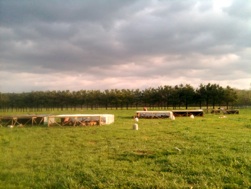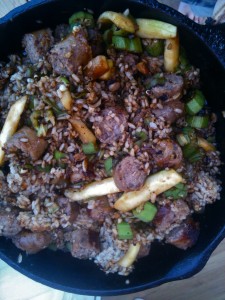by Katie of Farm Girl Food
I don’t hear this question at market as often as I once did (thanks Michael Pollan, et al), but it often comes up when discussing food and farming in other arenas. As I wrapped up a delivery to Hillcrest Artisan Meats just the other day someone stopped me with a whole slew of questions that often come bunched together; “Why local anyway? I can’t afford it all the time and I mean, I like eating broccoli and tomatoes and bacon whenever I want, is that so bad?” I suspect many people grapple with this topic in the age of the locavore. Since the fine ladies here at Arkansas Women Bloggers have loaned me a soapbox for the day, I thought it would be fun to unpack some of the “local” dogma and explain why eating local is important to me as a mother, a consumer of food, and a small farmer here in Arkansas.
Let’s be real, no one, not even the staunchest locavore only eats local all the time. We’re real people who go out to dinner, need something quick midweek, and want to feed our kids something healthy they’ll actually eat, even if that means broccoli or green beans every night all year long. Besides, what would I do without coffee? The point is this isn’t an all or nothing situation. We can have our exotic fruits, our Midwestern grains, and our local okra too. But when we choose local, even for just a few items, a lot more than a bundle of green beans is involved.
Consumer Freedom & Farmer Responsibility
We’ve all heard the countless, unending stories of dangerous bacteria making people sick (and worse), of pink slime, of terribly inhumane treatment of farm workers and animals alike. The halo of shock and revulsion around these stories is useful, since change must start with an awareness of the problem, but as soon as the next political scandal comes to light, we move on before the real message sinks in- these are actually stories of people being hurt by little or no corporate responsibility and abdicated choice on the part of the consumer. In plain speak, our giant food producing companies are no longer responsible to the consumer for the quality and integrity of their products, instead giving us exactly what we have chosen as consumers- cheap food at any cost. When something goes wrong with this system, it can take weeks or months to track down what happened, by which time hundreds or thousands of people have been injured. Then its up to some agency somewhere to dole out a punishment and reassure the public. Should we discover that we ate some of that same spinach or peanut butter, we have no recourse but to wait and see and maybe get a coupon for a replacement product, how do we know we won’t get the short straw next time? In this system, we’ve given up our power as consumers, and to me that’s not worth the gamble, no matter what the price of the cantaloupe was.

By contrast, when you shop with a local farmer (and here I’m talking about the ones that actually grow the items they sell), they are responsible to you from the very outset. They have just a handful of customers and every single one of them is vital to the successful livelihood of that grower. I’ve worked my own tail off to bring these things to delight and nourish you, I feed them to my own small children and my friends, and you know how and where to find me if something isn’t right. When you work with a local grower, you have the freedom, the right, to know everything you want about your food. You can ask me how I grew it, find out if my methods meet your standards, come by and see it growing if you like. This is something no seal or certification, no government agency can give you and something you won’t find in a grocery store.
Food Quality
I’m responsible not only for the safety of the foods I grow, but also how good it tastes and how it performs in your kitchen. If my Animal Welfare Approved, pasture-raised meats don’t make you feel good or fail the taste test, then no matter what touchy-feely Organic-y thing I have going on, I know you won’t be coming back for more. Your local growers have a lot more than bargain prices in mind when they’re growing your food and this often includes real, nutrient-dense, richly flavorful quality.
The improvement in quality when eating locally is most obvious when produce is considered- flavor alone makes it plainly clear when a tomato was picked ripe within the last 24 hours versus the picked-green-and-gassed options in most stores. Often the difference is not as immediately clear with meats, and yet it is there. Nearly all of our meat is sold frozen, and yet it is still fresher and of better quality than what can be found in grocery stores. Our meat is frozen within hours of processing and kept frozen until our customers choose to unfreeze, it unlike store meat which are often frozen and thawed many times before reaching the end customer. Through this process vital juices and the micronutrients they hold are replaced by preservatives and who-knows-what else. Yuck, no thanks.
But what about the money?
This is a top 5 question among market-going customers. They might be convinced on all the other reasons, but it still hurts to spend more than they’re used to compared to grocery store products. Boy do I get it, if I wasn’t the grower, we couldn’t afford to buy such high quality grass-fed and pasture-raised animal products and it’s taken me years to learn how to eat in line with local and “organic” ideals while not breaking the bank. From the other side of the table, I can tell you there’s no scheme or ploy, we charge the minimum that we need to make ends meet. As a small scale grower, and one committed to humane care practices, we don’t have the advantages of big guys in keeping prices down. We have no big machinery or automated feedlot systems. We buy our feed by the pallet, not on the commodity market. Our heritage breed animals grow more slowly than the Franken-meat-machines and take a little more feed to get there. We employ a local, family-owned butcher to do our cutting, not a dangerous, questionably staffed rendering plant. Our own sweat and muscle fills in when the ends don’t meet and it all comes together, penny by penny, to create a cost of production often higher than the retail prices in big box stores. There are of course, tricks to making each package stretch a little further, one of which is the recipe I’ve included below.
30 minute Sausage Skillet
This my go-to skillet dinner. Serves 4. For an Asian flair, try sesame oil, ground beef or mild sausage, and toss in a handful of plain peanuts.
Ingredients:
2-3 tbl coconut oil, olive oil, or lard
1 onion, diced
a couple cloves of garlic, crushed or chopped fine
Vegetables! These are all great options: A Half bunch of kale, ½ head cabbage chopped, a cup of purple hull peas, large handful of green beans, one yellow or zephyr squash sliced, diced eggplant, any tomatoes. The more variety, the better.
½ lb sausage, Linguica, chorizo, and jalapeno are all good options.
2 cups quinoa, whole wheat couscous, lentils, or precooked rice.

Steps:
- Begin preparing your quinoa or other base grain/pasta/bean
- Heat a heavy skillet (I use an extra large cast iron one) over medium heat. Add the oil and brown the sausage. I usually cook a whole package and set at least half aside for another meal.
- Once evenly cooked through, remove the meat leaving any sausage grease and oil that may have accumulated in the pan- remember, this is antioxidant-rich healthy fat from happy pastured animals. It will boost the flavor of your whole dish while passing along great omegas and micronutrients. Now add onions and garlic and brown gently. If you are including eggplant, I recommend adding it now since it can take a little longer than other veggies.
- After a couple minutes, add all the other, and toss. Cook for 10-15 mins, stirring occasionally.
- Toss in your cooked sausage and stir.
Add half of your quinoa or lentils or couscous or whatever it is you have been preparing, reserving the rest for another time. I like to add it directly to the mix in the skillet and toss together, but you may prefer to serve your stir-fry over the top of your grains. Salt to taste and serve.

Katie grew up in Berkeley, CA where she always dreamed of farming. In 2004 she made her way to Arkansas and started Farm Girl Natural Foods with a small flock of sheep. In 2007 she married her very own Ohio farm boy and together they started a family. Today, she and Travis work together with their two lovely young daughters to raise woodland hogs, grassfed cows, and pasture-raised chickens on their homestead and leased lands in Perry County.

Thanks so much for reminding us of the importance of supporting our local farmers.
Amen to the whole post!
I love this!!!
Love your post!